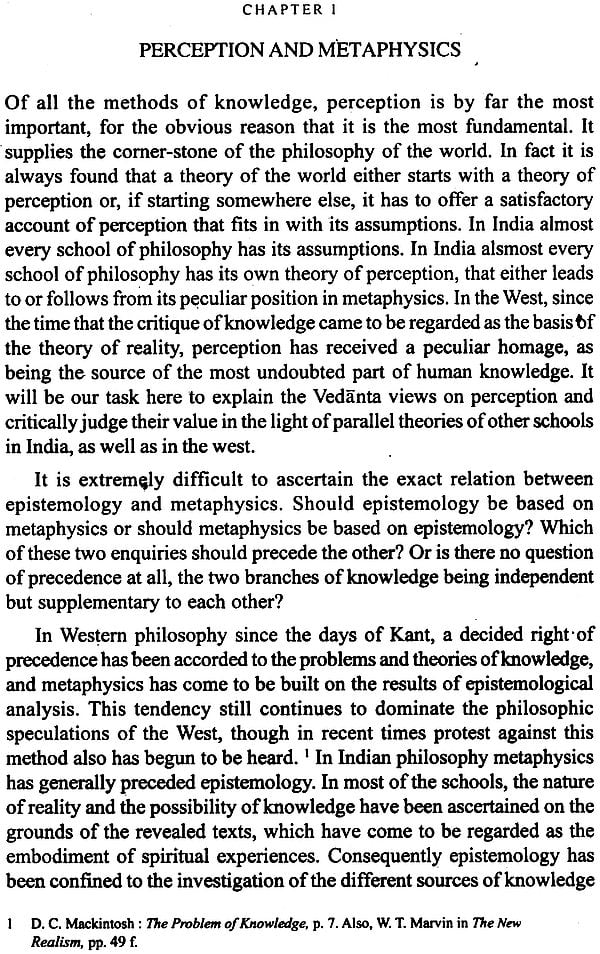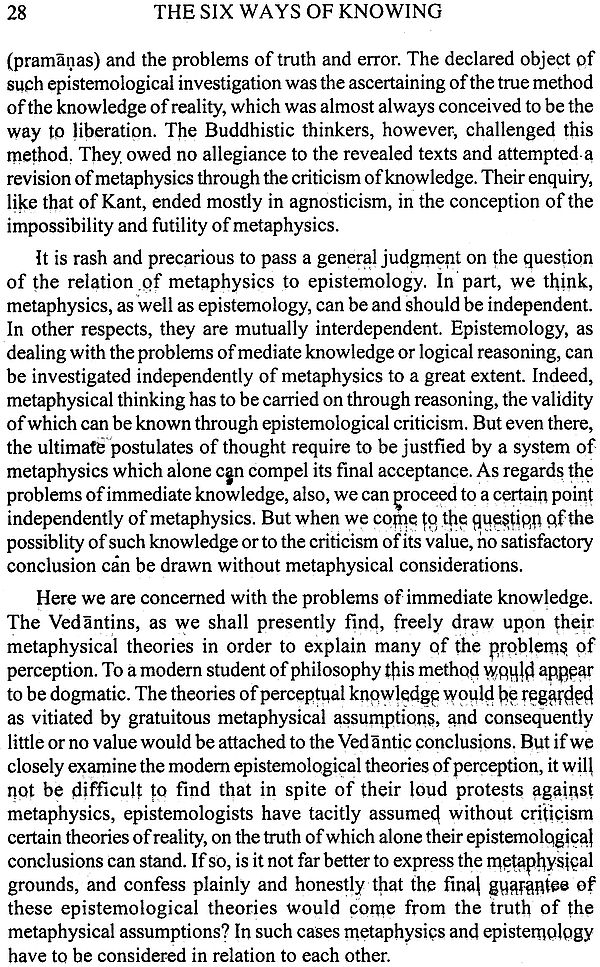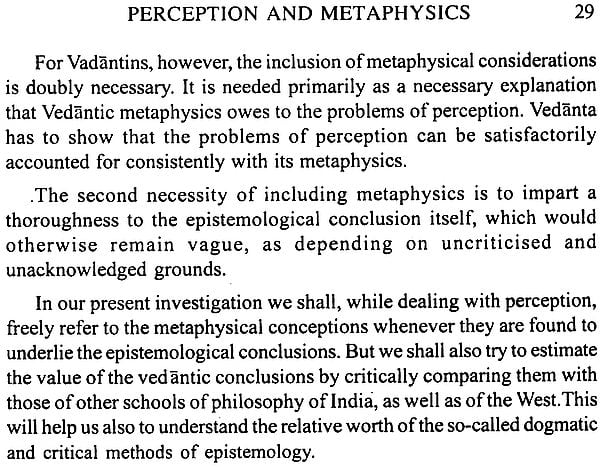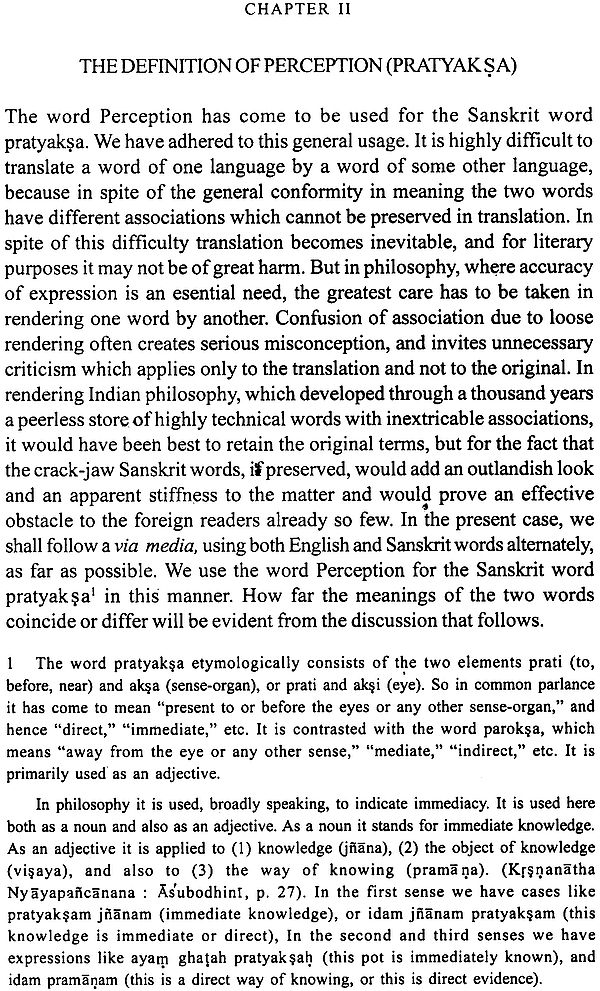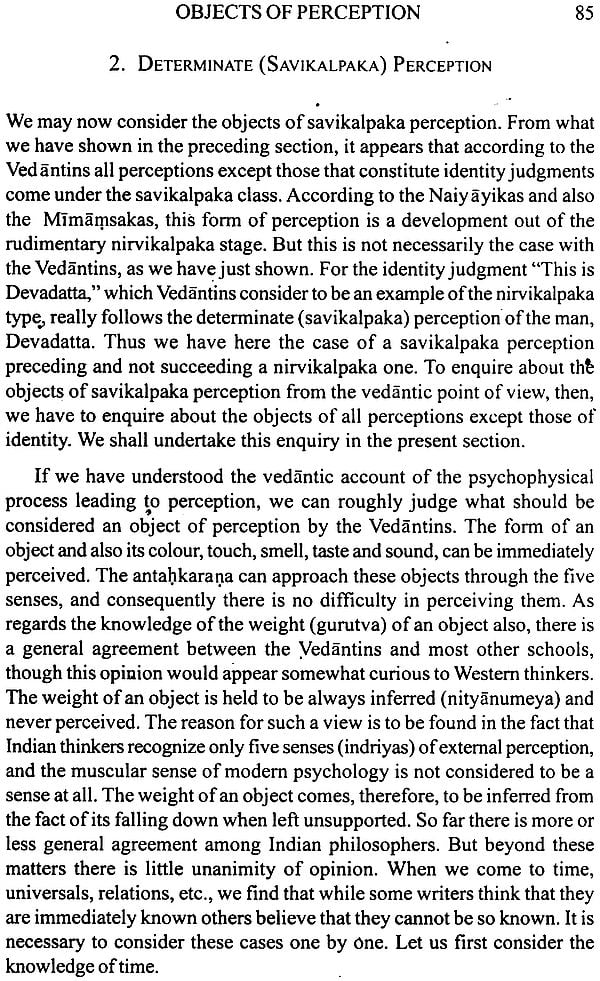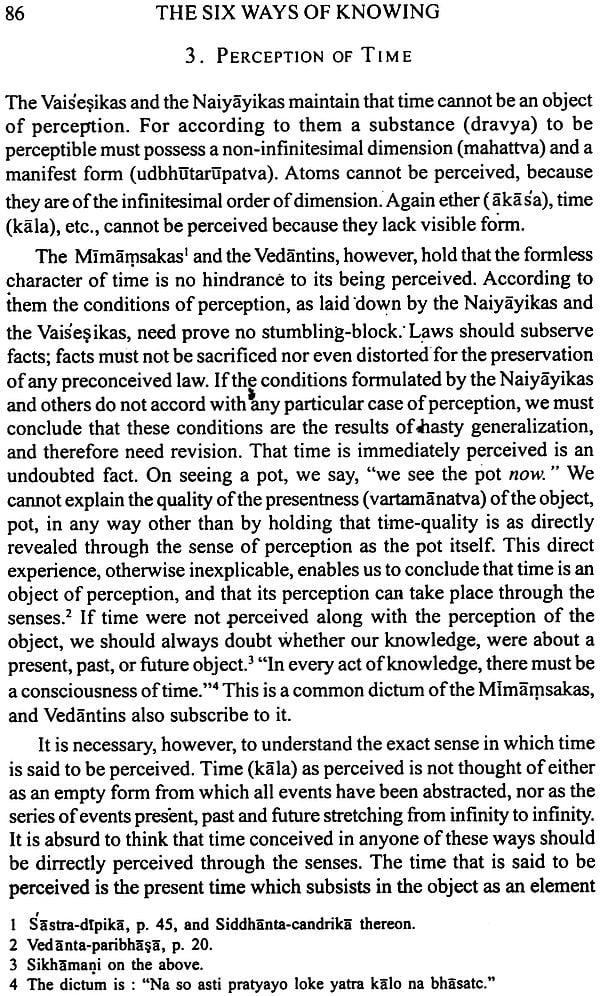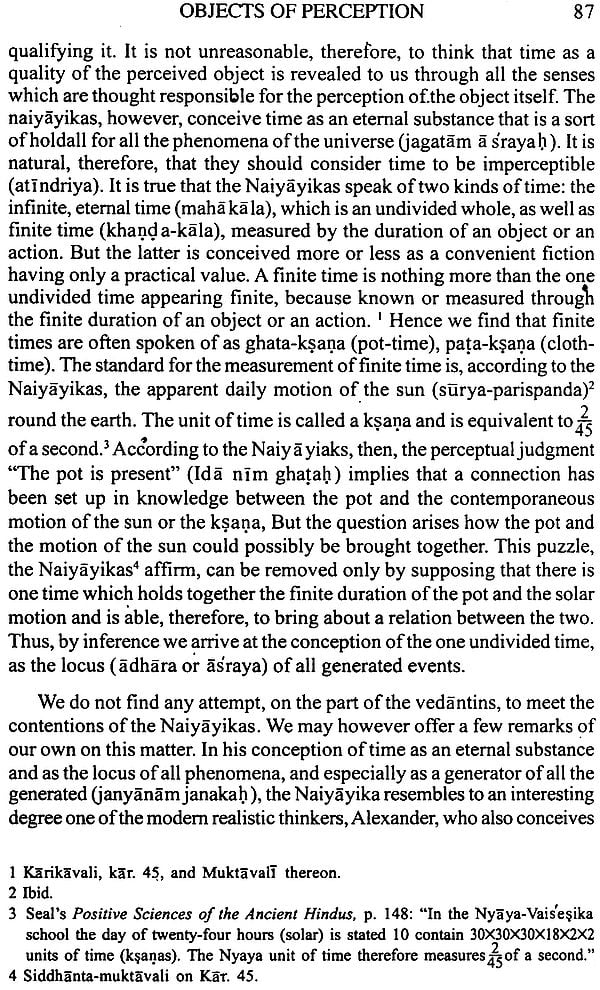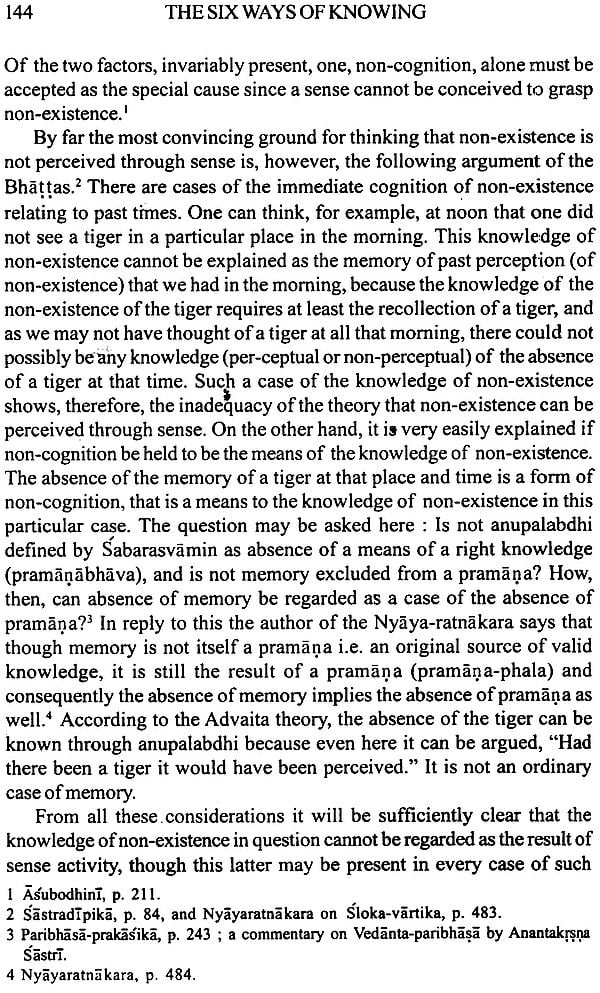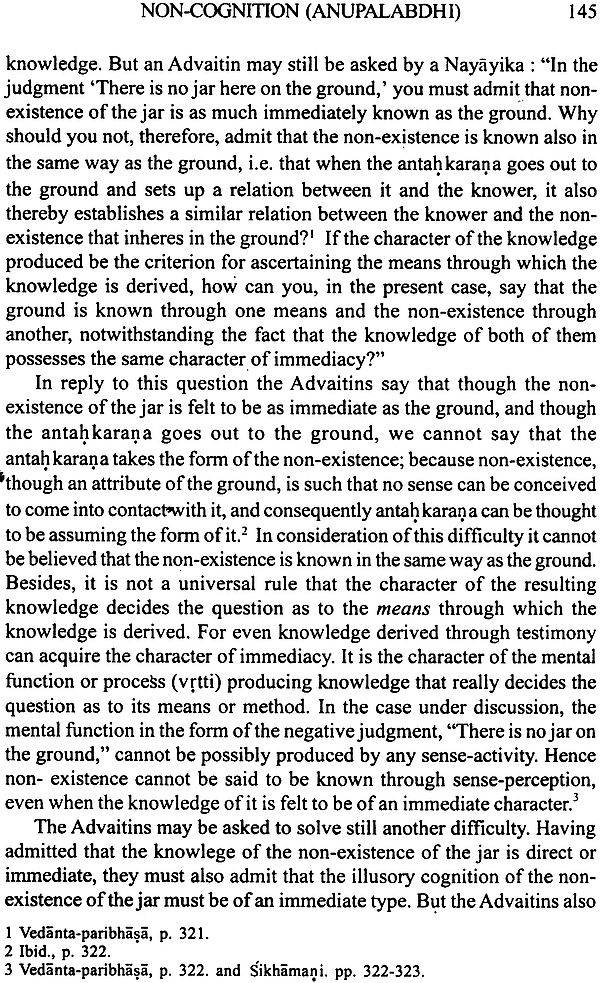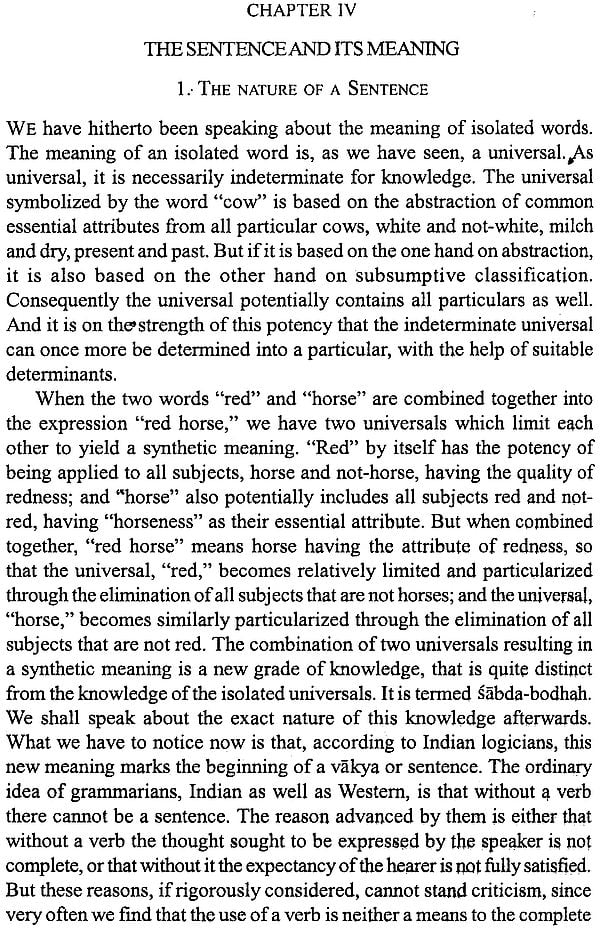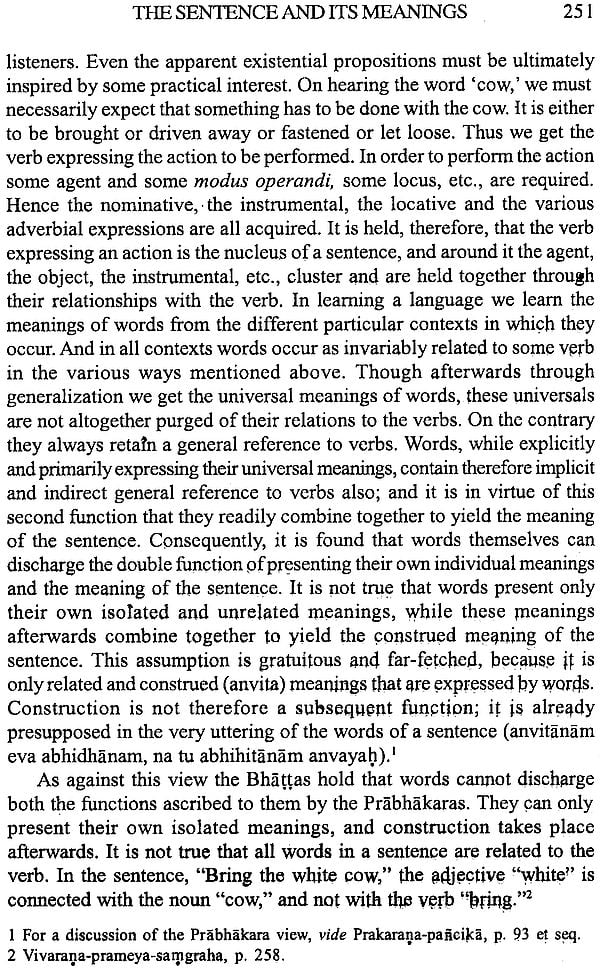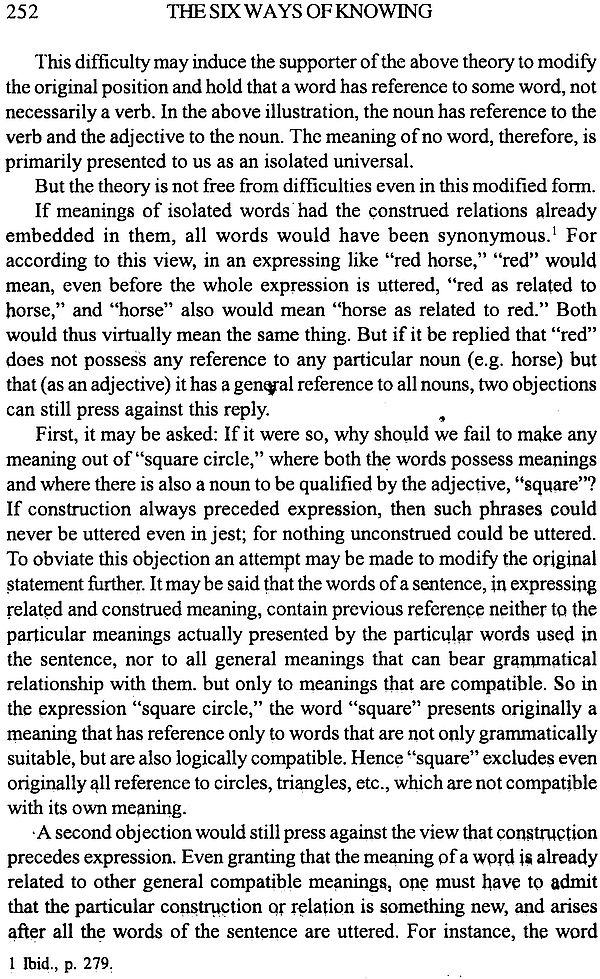
The Six Ways of Knowing
Book Specification
| Item Code: | IHL817 |
| Author: | D.M. Datta |
| Publisher: | University of Calcutta |
| Language: | English |
| Edition: | 2014 |
| Pages: | 306 |
| Cover: | Paperback |
| Other Details | 8.5 inch X 5.6 inch |
| Weight | 310 gm |
Book Description
This is an age of international understanding. Races and nations which dwelt and flourished apart are now coming into intimate contact and gradually tending to evolve a world of common ideas and beliefs. In Science such a common world of thought has already been achieved. In Philosophy the ideal, though not realized, is fast dawning upon the minds of thinkers. For the fulfillment of this ideal - for the evolution of a world-philosophy— what is best in every system. Eastern or Western, modern or ancient, requires to be gathered and added to the common stock. Any one who has a casual acquaintance with Indian Philosophy knows what valuable contributions it can make towards this common fund. Difficult as the task of interpretation is, some eminent scholars, both Indian and European, have already done valuable work in this direction. But much more yet remains to be done. This volume is an effort to that end. It tries to present, after critical analysis and evaluation. the contributions of some Indian thinkers in a special branch of Philosophy.
During the year’s 1925-28, the writer had the privilege of occupying the Praboth Chandra Basu Mallik Chair of Indian Philosophy at the Bengal National Council of Education. In Compliance with the wishes of the founder of this chair he was called upon to undertake some investigation in Indian Philosophy and publish the results of his labor. This volume represents his work in discharge of that duty.
He attempts to study critically some important epistemological theories of one of the chief schools of Indian Philosophy, namely, the monistic (Advaita) School of Vedanta. These theories mainly concern the question as to the nature and number of the ultimate sources of knowledge, and must be of great interest to students of modern European Philosophy, in which epistemology has come to occupy a central place. Western Philosophy has generally recognized two ultimate sources of knowledge, immediate knowledge or perception, and mediate knowledge or inference. But there has been a variety of opinions on this matter among the different schools of Indian Philosophy. Some hold that perception is the only ultimate source of knowledge. Some accept both perception and inference. Others add a third, testimony or authority, to these. Still others hold that comparison is an additional independent source of knowledge and should be combined with the above three. Others again contend that there is a fifth kind of knowledge, postulation, which is not reducible to any of the preceding. A few other thinkers hold that there is also a sixth type-non-perception—from which primary negative judgments are derived and which cannot possibly be reduced to any of the above. These views are not mere dogmatic assertions. Each school gives elaborate arguments for its own position. This book deals with the Vedanta standpoint. According to which there are six sources of knowledge. The conceptions of these different kinds of knowledge, with all the arguments given by the Vedantins to prove their independence and ultimacy, are critically discussed here in the light of modern Western concepts, and the attempt has been made to present the conclusions to students of Western Philosophy in a clear and lucid form.
As the purpose of this work is to bring the problems, concepts and theories of the Vedantins within the focus of modern Western thought, the method adopted is one of critical analysis, comparison and evaluation. Analysis has been necessary to isolate the epistemological issues from extraneous aspects with which they are often associated. It has been use full also in grasping accurately the significance of the Advaita view wherever ambiguity and vagueness seemed to be possible. It has been most necessary, however, in the study of the Sabda-pramana (testimony). Comparison with Indian and Western theories has been necessary to understand the exact position of the Vedantins with relation to that of other thinkers. Evaluation has been needed to ascertain the real merit of the Vedanta views on the grounds of reasoning. The adoption of this method has of ten necessitated the elimination of Sanskrit technical terms, the use of Western terms and concepts, the rearrangement of topics and the introduction of lengthy criticism—all of which have their justification only in the purpose of the work.
Throughout the book the writer has adopted the attitude of a student whose mind has been infected with doubts derived from the study of Western Philosophy, and who tries to understand, therefore, how far the Indian theories can satisfy his skeptical mind. For the audience, and every writer has some audience before his mind, he has imagined a tribunal of Western philosophers, mostly composed of anti-idealistic thinkers, with whom he tries to argue the case for Advaita-Vedanta as understood by him in order to carry conviction into their skeptical minds.
As to the value of such a study, it may be said that it tries to formulate in terms of Western Philosophy some important epistemological doctrines of Advaita—Vedanta, and to show by criticism that though they are generally neglected, they constitute when rightly understood valuable contributions to the Philosophy of the world. Its negative value consists in exposing the absurdity of certain commonly accepted theories of the East and the West, and in suggesting some problems that demand solution.
It may be necessary to note that words Vedanta and Vedant in have been employed, in conformity with the common Sanskrit uses of the terms, to signify Advaita—Vedanta and Advaita—Vedant in respectively for the sake of brevity, and they are to be taken in those senses except when any other meanings have been explicitly indicated.
It will be noted that the order in which the different pramanas (sources of knowledge) have been taken differs from the traditional order followed by the Advaita writers. Upamana (comparison) and anupalabdhi (non-perception), which will appear to Western thinkers to be obvious cases of perception, have been considered after perception. Again, arthapatti (postulation), which will appear to be nothing but inference, has been treated after inference. Sabda (testimony), therefore, has been placed last.
It may be necessary to mention here that the scope of the present work is limited to the consideration of the problems of knowledge (prama) alone; consequently the problems of error (aprama) have not been included. This latter occupies a large field in Avdaita-Vedanta, and thorough justice to it can be done only in an independent treatise.
The writer would fail in his duty if he did not express his gratitude to all his teachers He gratefully remembers first his early teachers, Professors Vanamali Chakravarty and Prabodh Chandra Sanyal, who first kindled in his mind the ambition to undertake a comparative study of Indian and Western Philosophy. He is indebted also to Dr. (now Sir) B. N. Seal, in whose versatile genius and incredible depth and width of scholarship his youthful ambition found a concrete embodiment and a source of lasting inspiration. He is grateful, further, for initiation into the original Sanskrit texts, to his teachers Mahamahopadhyaya Pandits Laksmana Sastri, Pramatha Nath Tarkabhushan, Ananta Krishna Sastri, and other learned Pandits.
He is specially indebted to the highly talented Pandit Jogendra nath Tarkatirtha, of the Sanskrit College, Calcutta, with whom he studied for about two years some of the more abstruse texts while writing this book.
For the critical method pursued in this work, he is indebted, more than to anybody else, to the silent, but profound thinker. Principal Krishna Chandra Bhattacharyya (now Professor. Calcutta University). For about three years he enjoyed the privilege of sitting at his feet discussing problems, removing doubts and reading texts. It is through the inspiring influence of this master mind that he picked up the rudiments of critical thinking, of which the present work is but an humble fruit.
Next to his teachers, the author is indebted most to the world-renowned thinker and writer Professor S. Radhakrishnan, of the University of Calcutta. From the very conception of the work till its completion Professor Radhakrishnan has most generously helped him by constant suggestion, guidance and encouragement. But for his kind encouragement and active sympathy the book would scarcely have been published in the present farm. The writer has the greatest pleasure, therefore. in expressing his gratefulness to him. He would thank also the distinguished Sanskrit scholar Principal Gopinath Kaviraj, of the Government Sanskrit College, Benares, for kindly reading some portions of the book and encouraging him with his valuable opinion.
He must thank, further, though in an un-Indian manner his own brother and teacher Professor Suresh Chandra Datta (of the Government College, Gauhati), who has been through the manuscript, corrected many mistakes made valuable suggestions which have enabled the writer to improve -Ii book in many respects.
Finally he must express his deep sense of gratitude to the Bengal National Council of Education, under the auspices of which this work was done. He is specially thankful, however, to its learned Secretary, Mr. Hirendra Nath Datta, and its Superintendent Mr. Hem Chandra Das Gupta,’ for constant help and encouragement. But for the facilities offered by the council the author could scarcely have conducted the investigations embodied in this work.
It is a great regret that in spite of a persistent demand for the book in India and abroad, it had to remain out of print, since the destruction of stock by enemy action over London. Though, in view of the losses, the previous publishers, Messrs. George Allen and Unwin Ltd., were kind enough to write to me, as early as 24th June, l946, relinquishing their rights to leave me "entirely free" to enable me "at once to approach another publisher", the difficulties created by the war also in India and my continuous pre—occupation with other works indefinitely delayed the necessary revision and re-edition.
Meanwhile requests for the book came from some Indian Universities which had recommended the book, and from foreign scholars, some of whom had to go to the British Museum Library and the Library of Congress to read it as ‘a rare book, not lent out’. When the book was revised, SirJnan Chandra Ghosh, the former Vice—Chancellor of the University of Calcutta, was kind enough to go through some of the relevant correspondence, and the University undertook the publication of the revised edition in 1956. But owing to heavy pressure of work the University Press could print it out only this year.
In the work of revision I have tried to keep to the original plan and size of the book. I have been benefited very much by the extensive, scholarly criticisms and suggestions received from Professor Kalidas Bhattacharyya of Vishvabharati University. Professor Ganga Nath Bhattacharyya, an esteemed former colleague at Patna College, favored me by going closely through the entire book, and suggesting many points for improvement. Professor Sudhindra Chandra Chakravarty of Vishvabharati and Atindra Mohan Gun of Calcutta Presidency College deserve my best thanks for reading some of the proofs. I must also thank Dr. Richard V. De Smet, S. J. (now a Professor at De Nobili College, Poona) who read the book at the British Museum, and used it for his Doctoral Dissertation for the Gregorian University, Rome, and reminded me repeatedly about the necessity of a second edition.
To my friend and former colleague at the University of Wisconsin Prof. William F. Goodwin, I am much obliged for lending me a copy of the first edition bought by him second hand but which had been previously owned and used by the late Prof. George Santayanta. Dreaming little that his copy will every find its way back to the author in India the great philosopher made free and profuse comments on the margin benefiting the author and also revealing himself as a keen patient and critical student of India thought.
Western Philosophy generally recognizes two sources of knowledge—Perception and Inference. But Indian Philosophy presents a variety of opinions on this matter. The Carvakas admit only one source of valid knowledge—perception. The Buddha’s and some Vaislesikas admit two sources—perception and inference. To these the Sarikhyas add a third—authority or testimony (Sabda). The Naiyayikas admit a fourth way of knowing—comparison (Upamana)—in addition to these three. The Prabhakaras again add to these four methods a fifth—postulation or assumption (arthapatti). The Bhatt as and the monistic Vedantins recognize, however, six methods of knowledge, adding non-cognition (anupalabdhi) to the five already mentioned. We shall discuss here all the six methods of knowledge, as admitted by the Advaitins, one by one.
But before taking up the problems of our study proper, it is necessary to discuss in brief the Indian conceptions of knowledge (prama) and the methods of knowing (pramana), because they underlie all epistemological discussions.
The Sanskrit word jnana stands for all kinds of cognition irrespective -of the question of truth and falsehood. But the word prama is used to designate only a true cognition (yathartha jnana) as distinct from a false one (mithya-jnana). In English the word knowledge implies cognition attended with belief. If, therefore, cognition turns out to be false, belief in it is immediately withdrawn and as such it should cease to be called knowledge. Consequently knowledge, strictly speaking, should always I stand only for a cognition that is true, uncontradicted or unfalsified. The ordinary division of knowledge into true knowledge and false knowledge should, therefore, be considered as an instance of loose thinking; the word true as applied to knowledge would then be a tautology, and the word false positively contradictory—false knowledge being only a name for falsified knowledge, which is another name for no knowledge.
If this logical meaning of the word knowledge be consistently and rigidly adhered to, knowledge will exactly correspond to the word prama. Prama is generally defined as a cognition having the twofold characteristics of truth and novelty (abadhitatva or yatharthatva and anadhigatatva).
As regards the first characteristic, truth, all schools of the Indian philosophy are unanimous. Every philosopher holds that truth should be the differentia of knowledge or prama. But views as regards the meaning of truth vary, and consequently the mark of a prama is variously expressed. Broadly speaking there are at least four different views about truth.
According to one view the truth of knowledge consists in its practical value. A true cognition is, therefore, variously defined as that which reveals an object that serves some purpose (artha or prayojana) or leads to the achievement of some end or which favors a successful volition (samvadipravratya-nukula). This view will at once be seen to resemble the modern pragmatic theory of the West. It is mostly held by the Buddhists, but other writers also occasionally support it.
Another view, that we find chiefly in the Nyaya works, regards truth as the faithfulness with which knowledge reveals its objects. True knowledge is, therefore, defined as that which informs us of the existence of something in a place where it really exists, or which predicates of something a character really possessed by it. This view resembles the correspondence theory of Western realists
A third view, which is incidentally referred to by many writers, regards truth as a harmony of experience (samvada or sanavaditva). A true knowledge according to this view, would be one which is in harmony with other experiences} This view again resembles the Western theory of coherence.
The Advaita school of Vedanta, however, favors a fourth view according to which the truth of knowledge consists in its non contradicted ness (abadhitatva). The correspondence view of truth cannot directly prove itself. The only way to prove correspondence is to fall back1 1he foreign method of consilience or coherence (samvada)—that is to infer the existence of a real correspondence between knowledge and reality from the facts of the harmony of experience. But all that we legitimately infer from the harmony of knowledge with the rest of ours experience up to that time, is not that the knowledge is absolutely free from error, but that it is not yet contradicted. For we do not know that we shall rut have in future any experience that can falsify our present knowledge. As regards the pragmatic test of causal efficiency (artha—kriya—karitva),the Advaitins argue that even a false cognition may, and sometimes does, lead to the fulfillment of a purpose. One of the examples; they cite to support their view is the case of a distant bright jewel which emits luster. We mistake the luster for the jewel and, desiring to get the mistaken object our knowledge, approach it and actually get the jewel. In this case, here fore, the knowledge of luster as the jewel—which is clearly a false cognition—leads to the attainment of the jewel and thereby satisfies our purpose, though eventually we come also to know that the initial cognition which caused our action was itself false. We can multiply instances of this kind. The hypothesis that the earth is stationary and the sun is moving as been working quite satisfactorily for ages; on the basis of this cognition many of our actions are performed and purposes attained. It is only its conflict with astronomical phenomena that enables us to detect its falsity.
It is found, therefore, that the pragmatic view of truth is not tenable. The correspondence view has ultimately to fall back on the consilience or coherence theory which, when subjected to strict scrutiny, has to yield the result that truth, as ascertained by it, consists only in its non-contradicted ness.
According to the Advaitins, therefore, prama or knowledge must have as one of its characteristics truth; and the truth of prama consists its content being uncontradicted (abadhitartha-visayakatva).
The second characteristic of prama or knowledge is, as we have already said, novelty. It is not sufficient that knowledge should he true, it is also necessary that the content of knowledge should be new or previously unacquired - anadhigata. On this point, however, not all authorities are unanimous; while some (e.g. Mimamsakas) consider it to be an essential part of the differentia of knowledge, others; think it unnecessary as unduly narrowing the scope of knowledge. The Vedantists see in to be rather indifferent to this controversy and unwilling to take sides. The material ‘part of the controversy turns upon the question whether memory should be admitted to have the status of knowledge. If truth be the sole characteristic of knowledge, memory, in so far as it is uncontradicted or undoubted, has to be called knowledge. But there is a peculiarity about memory that deserves special consideration. The only claim of memory to belief lies in its explicit reference to a past experience which it professes to reproduce faithfully. A remembered fact is believed to be true just because it is regarded as identical with the content of a past experience which it claims to represent. This confessed and explicit falling back on the past experience means its self-abdication in favor of its archetype. Thus the question of treating memory as a distinct type of knowledge does not at all arise, being barred ex hypothesis. The only kind of knowledge is then the knowledge of the already unacquired. But though memory is not a distinct source of knowledge, it is still a distinct experience that has to be distinguished from knowledge and given a separate name. The experience which reveals the new (i.e. knowledge proper) is called anubhuti, where as reproduced knowledge is called smrti. Thus novelty comes to be considered an essential quality of knowledge.
If this be the conception of knowledge (prama), the question then arises whether in the case of a persistent knowledge of the same object, our experience at every moment during that time can be regarded as knowledge. When I keep looking at a table for some moments continuously, my experience of the first moment as an acquisition of the new is of course to be called knowledge. But what about the experiences of the subsequent moments? Can they also be rightly called knowledge seeing that they only reveal to me what has been already acquired at the first moment and lack there by the quality of novelty?
| Preface | 11 |
| Introduction : Knowledge and the methods of Knowledge (Prama and Pramana) | 17 |
| | |
| Perception (Pratyaksa) | 25 |
| | |
| Perception and metaphysics | 27 |
| | |
| The Definition of Perception (Pratyaksa) | 30 |
| | |
| The Psychology of Perception | 34 |
| 1. The Conception of Sense (Indriya) and its function | 34 |
| 2. The Conception of Mind (Manas or Antahkarana) | 40 |
| 3. The Function of Mind (Antahkarana) in perception | 52 |
| | |
| The Place and Function of the Self in perception | 62 |
| | |
| Objects of Perception | 77 |
| 1. Indeterminate (Nirvikalpaka) Perception | 78 |
| 2. Determinate (Savikalpaka) Perception | 84 |
| 3. Perception of Time | 85 |
| 4. Perception of Universals relations etc. | 89 |
| 5. The Nyaya Theory of Extraordinary (Alaukika) Percetion | 101 |
| 6. Internal Perception | 110 |
| | |
| Comparison (Upamana) | 119 |
| 1. The Problem | 121 |
| 2. Is Upamana an Anumana (Inference)? | 122 |
| 3. Is it a perception? | 123 |
| 4. Is it Partly a perception and partly a memory? | 124 |
| 5. The Nyaya View of Upamana | 125 |
| 6. The Evidence of Western Logic: Is Upamana an Immediate Inference? | 126 |
| | |
| Non- Cognition (Anupalabdhi) | 133 |
| 1. The Problem of Anupalabdhi | 135 |
| 2. The Views of the Prabhakaras and the Samkhyas | 135 |
| 3. The Views of the Naiyayikas | 136 |
| 4. The Views of the Bhattas and the Advaitins | 137 |
| 5. Objections Answered | 142 |
| 6. The objects of Non perception the four kinds of non Existence | 146 |
| 7. Critical Estimation of Anupalabdhi | 154 |
| | |
| Inference (Anumana) | 169 |
| 1. The Meaning of Anumana | 171 |
| 2. The Conception of Vyapti (Invariable Concomitance between the middle and the Major Terms) | 172 |
| 3. How is Vyapti to be Ascertained? | 173 |
| 4. The Function of Vyapti : the Psychology if Inference | 177 |
| 5. Does Inference Yield any new knowledge? | 181 |
| 6. The Form of the Syllogism | 182 |
| 7. The Classification of Inference | 184 |
| 8. The Psychological conditions of inference: the Theory of Paksata | 192 |
| | |
| Postulation (Arthapatti) | 197 |
| 1. The Problem | 199 |
| 2. Is not Arthpatti an Anumana? | 200 |
| 3. Are all inference Reducible to Arthpatti? | 204 |
| 4. Criticism and conclusion | 205 |
| | |
| Testmony (Sabda) | 207 |
| Introduction | 209 |
| | |
| The Process of Sabda Jnana | 211 |
| Sensations of Sound | 211 |
| | |
| The Perception of word symbols | 214 |
| 1. How sound series of perceived? | 214 |
| 2. The Theory of Sphota | 215 |
| 3. The Advaita view and Criticism | 218 |
| | |
| Words and Meanings | 221 |
| 1. Words as Symbols | 221 |
| 2. Is Primary meaning Particular or Universal Five Views | 224 |
| 3. The Advaita View critically Considered | 229 |
| 4. Is any word Non Connotative | 236 |
| 5. Primary Secondary and Tertiary Meanings | 244 |
| | |
| The Sentences and its Meaning | 249 |
| 1. The Nature of a Sentence | 249 |
| 2. Does Construction precede expression two Views | 250 |
| 3. Conditions of Significant combination | 259 |
| 4. The Conception of a Proposition | 265 |
| 5. Do All Propositions Contains substantive adjective Relation | 267 |
| 6. Some Identity propositions Advaita view and western Criticism | 269 |
| | |
| The Objective Reference in a sentence | 279 |
| | |
| The Validity of verbal Knowledge | 283 |
| Index | 297 |
